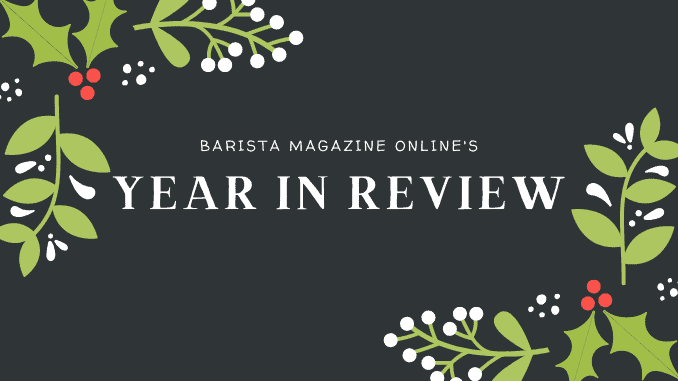
We cover the most popular conversations and subjects from the coffee world this year.
BY KATRINA YENTCH
BARISTA MAGAZINE ONLINE
2021 was a rough year. COVID wasn’t done pulling at our every string of patience, and yet our community had no choice but to keep holding on. We experienced waves of continued shutdowns, but with less shock and more preparedness. However, as our cafés continued adapting to the new normal, and as we burrowed deeper into our homes, we pushed coffee’s boundaries.
Baristas and service workers across America became enlightened over their crucial role in the fabric of our society, and demanded the respect they deserved for that—whether employers honored it or not. The distance between farmer and barista decreased, as the internet and social media made it easier to understand the true meaning of crop to cup, which resulted in justifiably higher prices than ever for top-quality green coffee. And, the café consumer-turned-home brewer aficionado proved to be coffee’s most valuable buyer yet, with endless innovations, subscriptions, and educational content all geared toward the enjoyment of coffee in one’s own living room. Still, we ultimately desired the lost connections we needed from in-person gatherings, and took the leap of faith in vaccinated environments, donning our masks to pour fabulous designs at latte art throwdowns.
It’s been a weird year, but simply put, we’ve made it work. Here are five crucial trends that drove the coffee industry forward in 2021:
Giving New Varieties Notoriety, and the Quest for Resilient Ones
As climate change continues to threaten the future of our industry in every way possible, coffee farmers aren’t about to lose that battle just yet. We’ve played witness to lesser-known coffee-growing nations increasing their specialty production, coffee competitors going beyond Gesha to give other varieties exposure, innovative processing techniques, and efforts to make Robusta a species as revered as Arabica.
Buying Nicer Coffees
Although cafés opted to buy more affordable options at the start of the pandemic (80-83-point-scoring batches), we witnessed a sudden reversal of that in 2020. People decided they wanted to treat themselves during a rough time, and coffee was the perfect affordable way to do that. 2021 certainly took advantage of that sentiment, with producers left and right participating in Cup of Excellence auctions for the first time ever. Roasters took the gamble to buy smaller batches of incredibly rare coffees, resulting in offerings that sold out within minutes of being announced. Coffees like Eugenioides, Wush Wush, varieties from Yemen, and the SL 28/34 varieties proved to be true crowd favorites.
Brewing Technology
As staffing shortages continue, automation has become more relevant than ever. Automated equipment at the café level has made handling rushes that much easier, and yet espresso machines with endless programmability rely on the skilled mind of a barista/coffee scientist to pull the most mind-blowing shot ever for patrons. Today’s café-grade equipment caters to both styles of coffee service.
Home brewing continues to push the buttons, offering us gadgets we didn’t even realize we needed till they were invented. It’s been an Amazing Race-style pursuit by both specialty-coffee brands and kitchen equipment companies to build the best home drip coffee maker, and with these all of these items come an assumption that they’re going to be incredibly design-forward. At this point in home brewing, nice coffee doesn’t just taste good—it has to look good, too.
Barista Empowerment
The phrase ”essential workers” may have initially sounded insincere during 2020 catastrophes, especially given the amount of money that American stimulus checks paid out compared to that of unemployment. In 2021, workers made it more important for consumers and employers to understand the value of their role in enjoying ”normal life things” like going out for coffee and sitting down at a café.
As a result, we’ve witnessed baristas more willing to leave a job that didn’t offer substantial benefits, and a demand for wage transparency from employers hiring new people. The barista’s status in the workforce has certainly been challenged in American culture, and the result has been shorter and shorter operational hours at coffee shops across the country.
The Return of In-Person Events
We tried, we really did, to enjoy a Zoom event. And it proved to be a great way to connect coffee people across the world, including those whom we may have otherwise never encountered at a real event. But eventually we realized, who are we kidding? Nothing beats seeing a person in real life over coffee versus on a screen. As soon as vaccines became available to a greater population, we started hosting trade shows, latte art throwdowns, and started to let folks enter the café in smaller numbers.
Now this is where it varies heavily, from country to country and even between neighboring cities. COVID-19 has certainly exposed the challenges, hardships, and privileges that certain countries experience, which becomes reflected in changing restrictions and vaccine availability.
We have to understand and respect that while some countries are ready to re-open and host live events, others either can’t or don’t want to. And we can’t judge one decision or another for that. Fully re-opening, choosing to remain closed, or hosting an event at full capacity is at the discretion of each individual entity now, and it’s up to the opinions and sentiments of each community to decide what they’re capable of doing. In the meantime, all we can do is hope for brighter days, and an end to changing variants.
For now, we’ll continue to make it work.

